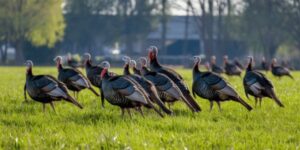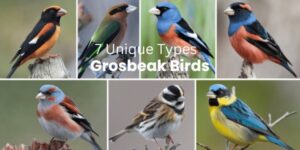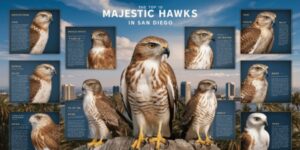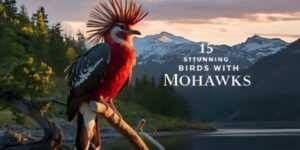Grosbeak birds, known for their striking plumage and robust beaks, are a diverse group of birds that belong to the family Cardinalidae. These birds are primarily seed-eaters, with their powerful, conical beaks designed for cracking open seeds and nuts. While grosbeaks are found in various regions across the globe, this article will focus on seven notable types that are particularly fascinating due to their appearance, behavior, and habitat.
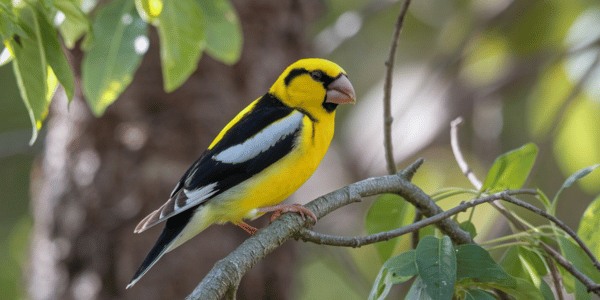
Evening Grosbeak (Coccothraustes vespertinus)
Identification and Characteristics
Evening Grosbeak is a colorful songbird with a heavy bill. Males have bright yellow bodies with black wings highlighted by white patches while females and young one have dull grayish-brown coloration with patches of yellow. They have thick necks and short tails too. Typically measuring around 8 inches long, these birds possess a wingspan of about 12 inches.
Habitat and Behavior
Native to North America, the Evening Grosbeak inhabits coniferous or mixed woods especially in northern parts of America. They often move in flocks mainly during winter when they may be seen at bird feeders in huge numbers. In addition to seeds; they eat insects as well as tree buds. The Evening Grosbeak’s flight is powerful while its calls are usually clear enough even from far.
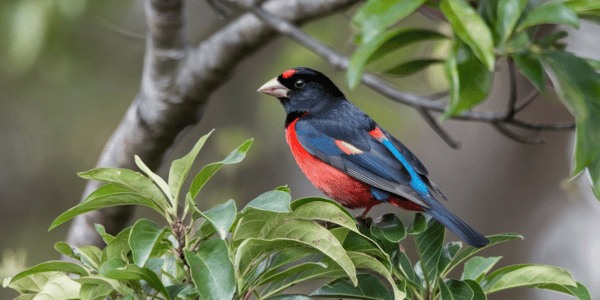
Rose-breasted Grosbeak (Pheucticus ludovicianus)
Identification and Characteristics
The male Rose-breasted Grosbeak has a red patch on its breast which contrasts sharply against its black head, back, and wings. The wings have white patches that can be noticed while it is flying; however, this coloration is lacking in females that instead resemble large sparrows with brown-streaked feathers. Medium-sized species measure between 7-8 inches long having approximately 12.5-inch wingspans.
Habitat and Behavior
This species thrives in deciduous and mixed forests within eastern and central North America. They usually prefer congested vegetation and are commonly observed near water. Rose-breasted grosbeaks are migratory birds that winter in southern South and Central America. They feed on insects, seeds, and fruits among other things. Their song is known for its sweetness as well as being similar to that of an American robin but males as well as females take part in incubating eggs and feeding the young.
You May Also Like: Top 10 Hawks in San Diego: (Majestic Birds of Prey)
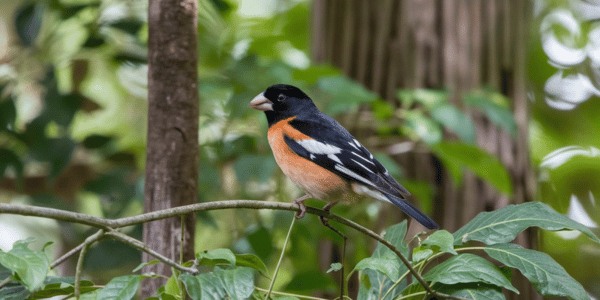
Black-headed Grosbeak (Pheucticus melanocephalus)
Identification and Characteristics
The Black-headed Grosbeak is another member of the Grosbeak family; the males have a combination of orange, black, and white coloration which looks amazing. The head is mostly black while the body has a bright orange breast with black wings featuring white patterns on them. Females resemble sparrows but have sturdier bodies with brown coloration below their underparts. These birds measure about 7-8 inches long; their wingspan is approximately 12 inches.
Habitat and Behavior
The Black-headed Grosbeak is generally found throughout the western United States in deciduous woodlands close to streams or rivers, although they can also be seen in mixed forests and shrubby sites too. During migration, they go to Mexico through Central America. Insects, seeds, and fruits including sunflower seeds are what their diet consists of mainly. The male sings a rich warbling song while both sexes sing; moreover, it has been noted that they eat Monarch butterflies which most predators can’t stand because they are poisonous.

Blue Grosbeak (Passerina caerulea)
Identification and Characteristics
In males, the Blue Grosbeak is a tiny bulky bird with vibrant blue feathers while females are brown with light blue coloration on wings and tail. The deep blue of the males is usually most apparent during the mating season. They have beaks that are large and cone-shaped to eat seeds with their wings having two distinct russet-coloured bars. These birds measure about 6.5-7.5 inches long, and they have a wingspan of around 11 inches.
Habitat and Behavior
Shrubby habitats, open fields, and woodland edges are preferred by Blue Grosbeaks, particularly in the southern United States as well as parts of Central America. They fly to Central America for the winter migration period and return to the US for breeding season through which they mainly make sound using insects. Their diet primarily consists of insects and seeds. They produce sweet melodious songs that serve as territory demarcation signs to attract mates among other things . Their nests are often concealed by thick foliage but can also be built in low shrubs or trees.
You May Also Like: Black Birds With White Wings: A Fascinating Avian
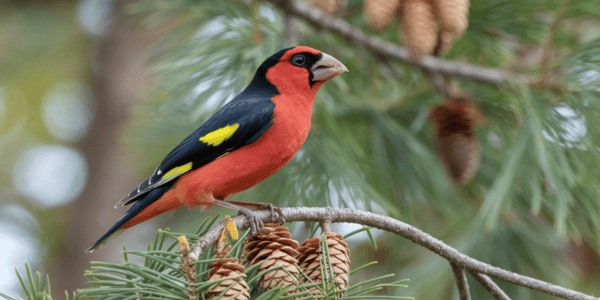
Pine Grosbeak (Pinicola enucleator)
Identification and Characteristics
The Pine grosbeak is a thick-billed finch that has a relatively large body size but whose length of tail slightly forks at the end; it is quite plump. Males have mostly reddish-pink bodies with gray tails and wings, whereas females possess more yellow-grey bodies compared to their male counterparts. The largest specimen grows up to about 8-10 inches long when measuring from the tip of its head up to its nether end while flapping both arms wide apart would stretch out its wings for about 13 inches’ lengthwise span from one side wingtip right across beyond another including central body mass between them as this makes them easy to identify due to their size.
Habitat and Behavior
Pine Grosbeaks prefer boreal forests and mountainous areas in the northern regions of North America, Europe, and Asia. They are most commonly seen in coniferous forests with spruce, pine, or fir trees. These birds often go around in pairs or small flocks foraging for seeds, berries, and buds on trees and shrubs. These calls of theirs are rather quiet though gentle and mellow, unlike their songs which could be loud enough for everyone who can hear them from a far distance. When winter comes, one can see these birds coming to feeders where they prefer sunflower seeds as well as other large seeds.
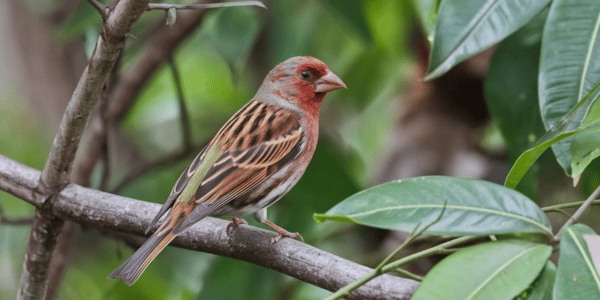
House Finch (Haemorhous mexicanus)
Identification and Characteristics
The House Finch is a small bird that has a conical bill with a tail that is noticeably notched at the end. The heads, throats, and chests of males are reddish while the rest of their bodies are brown with stripes running across them all over. On the other hand, females do not possess these red colors but they look brown along with stripes. These birds measure about 5-6 inches long, and have an exact wingspan of 8-10 inches from one wingtip across the central body mass up to another tip at the opposite side.
Habitat and Behavior
These birds were originally found only in the Western United States but today they are present throughout the continent. They easily adapt to various conditions including those found in cities’ environs or even countryside settings like farms. This kind mainly eats grains together with fruits plus flower buds hence its diet mainly consists of seeds, fruits, and buds. At bird feeders, you clearly understand that this kind loves sunflower seeds because it prefers eating them compared to any other type of food that may be available there. House Finches sing cheerful warbles during breeding times; so these sounds normally come out when there is light shining brightly all around through the day. They form small groups or flocks and are sociable birds.
You May Also Like: 20+ Colorful Backyard Birds in Michigan
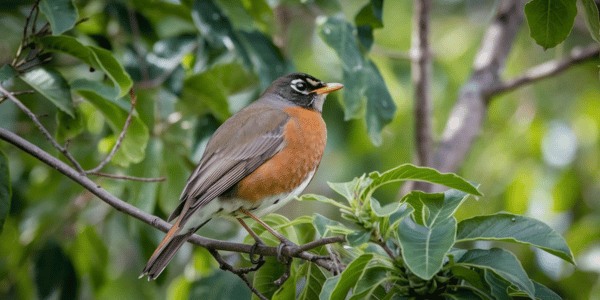
American Robin (Turdus migratorius)
Identification and Characteristics
One of the most common bird species in North America is the American Robin which is easily identified by its orange-red breast, gray upperparts, and throat that is white with black streaks. Long pointed beaks as well as round-shaped heads are some of their features. The wingspan ranges from 12-16 inches while lengthwise it measures about 9-11 inches long.
Habitat and Behavior
North America is home to American Robins, which reside from Alaska to Mexico. As ecological generalists, they occupy a variety of landscapes that include forests, gardens, parks, and urban areas. These are often found in lawns where they peck at large numbers of earthworms; fruits and berries also make up an important part of their diet. They are famous for their sweet song which is like the whistle of spring that can be heard all over the yard. They breed early with males singing to defend territories and attract mates. The robins’ nests are shaped like cups and often have mud as additional reinforcement.
Diet and Feeding Habits
Grosbeak birds belong to the granivorous group since most of them feed mostly on seeds. Their robust bills enable them to crack open tough seed shells easily. Conversely, their diet may vary depending on seasonal changes such as availability.
• Seeds: At times when other food is scarce such as during winter, Grosbeaks mainly eat seeds.
• Insects: Many species including the Rose-breasted Grosbeak switch to eating insects more within this period since raising chicks requires high protein diets.
• Fruits and Berries: Fruits and berries are also eaten by grosbeaks because they offer high-energy nutritional value, especially during migration periods. One example is the Black-headed Grosbeak that feeds on various fruits like wild cherries and elderberries among others.
Feeding Behavior
Mostly seen feeding in trees or shrubs where they use robust beaks to break open seeds or pluck at fruits. They also frequently visit seed feeders to get sunflower seeds and other big seeds that are easy to crack.
During the breeding season, Grosbeaks may become more territorial, especially around food sources. However, they are generally social birds, often feeding in flocks during the non-breeding season.
Breeding and Nesting
Grosbeak birds are monogamous meaning that their pair bonds last through the breeding period. Males sing to attract mates while females build nests with the help of their partners.
Nest Construction
Typically concealed among dense foliage in trees and shrubs where predators cannot locate them. These nests include a cup-shaped structure made up of twigs, grasses, or other parts surrounded by softer materials such as feathers; hair is another common component.
• Rose-breasted Grosbeak nests are typically located on deciduous trees or shrubs at heights ranging from 5ft up to 15ft above ground level.
• Black-headed Grosbeak nests can be found in thickets or trees usually close by water sources.
Eggs and Incubation
The female lays an average of three to five eggs which she incubates for about 14 days. Either parent may perform these duties for different intervals while the young ones develop into hatchlings. When hatched, the chicks are altricial implying that they are blind and naked hence totally dependent upon adults for food provision as well as safety purposes.
You May Also Like: Blue Grosbeak Vs Indigo Bunting: How To Tell These Blue Birds Apart
Conservation Status and Threats
The International Union for Conservation of Nature (IUCN) presently classifies many species of Grosbeak as being least concern species, but they still face several threats that could affect their populations in the future.
Habitat Loss
Habitat loss is one of the major threats to grosbeaks’ populations especially within their breeding and wintering grounds. Cutting down trees and turning natural landscapes into agricultural or urbanized lands reduces the availability of suitable nesting areas and food sources.
Climate Change
Climate change also poses a challenge due to its influence on food availability and migration timing. Changes in temperature and precipitation patterns can alter the abundance of seeds, insects, and fruits which are highly important for Grosbeak’s survival, especially during migratory and breeding periods.
Pesticides
Another threat is posed by the use of pesticides in agricultural regions, particularly by insects consuming rose-breasted grosbeak. Insecticides may decrease insect numbers affecting bird species that depend on them as food.
Conservation Efforts
Efforts at conserving Grosbeak birds include habitat preservation, especially in crucial breeding grounds and wintering areas. Maintaining/restoring wooded habitats; creating protected zones; and encouraging sustainable agriculture are vital to ensuring these birds’ survival.
In addition, planting native trees and shrubs in urban/suburban areas will provide important food/nesting sites for Grosbeaks while their natural habitat continues to shrink.
The Role of Grosbeak Birds in Ecosystems
Grosbeaks have a significant role in ecosystems particularly seed dispersal. They help spread plant species by feeding on various kinds of seeds/fruit ensuring forest diversity is maintained such as forest health.
Furthermore, consumption of large amounts of insects by Grosbeaks during breeding season helps to control insect populations thereby benefiting farms while reducing dependence on chemical pesticides.
Conclusion
Grosbeak birds are an amazing group of species, with each having unique characteristics and behavior. From the colorful Evening Grosbeak to the striking Blue Grosbeak, these birds are a delight for birdwatchers and nature lovers too. To protect their habitats and allow future generations to enjoy their beauty and diversity as we continue studying them, we must conserve their habitats. We therefore contribute to the larger effort of protecting the world around us by understanding and conserving these wonderful birds.







